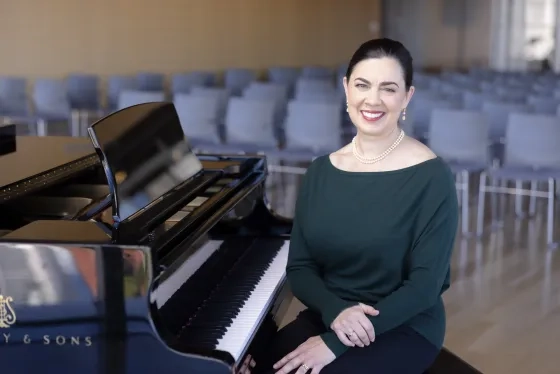Want to Know, Scientifically, How Your Voice Works? Take This Class
Dr. Julia Nielsen uses her class to dispel misconceptions and give students the clearest roadmap possible for a career of healthy singing.
You probably won't build a model of the solar system at SFCM, but in at least one class, arts & crafts will help you understand your instrument—even when it's the human voice.
Dr. Julia Nielsen, whose SFCM vocal physiology class can be the first time students learn how their instrument actually works, is the reason for that. "We study the systems that make up the human voice from a scientific perspective, but also from a practical perspective." "Practical" can also extend to the pedagogy itself: Nielsen shows students the interaction between their diaphragm and their lungs by having them assemble a model out of a cut-up soda bottle, a straw, and some balloons.
Nielsen acknowledges that other students aren't required to learn about the mechanics of their arms and fingers, for example. But, she says, that's because "Throughout history, voice as a discipline has often been taught based on image and metaphor, which can be extremely useful. But for students, I always like to be able to tie vocal pedagogy back to something actual, concrete, and literal in the body that we're trying to affect."
For example, the aforementioned model was built for a unit on respiration, to illustrate an oft-repeated bit about the human voice. "A common misconception about the diaphragm is that it is active when we exhale," Nielsen says. "And this is actually backwards. The diaphragm is active when we inhale, and it's in the process of relaxing when we exhale." Some light crafting later, students can see the concept play out externally, like an instrumentalist would correct hand or finger technique.
The class fits SFCM's mission of educating the complete musician in that Nielsen wants her students to not only internalize the information she's presenting them, but use that knowledge to become savvier consumers of other information. "It is, unfortunately, not uncommon for singers to be given technical advice that is, in fact, totally at odds with the way the instrument actually works," she says. "And singers who are armed with this information can do a better job of assessing, interpreting, and maybe even rejecting advice that is not in line with the science."
For students who are as interested in pedagogy as performance, it's the first step in combating decades—sometimes centuries—of myths around singing and breaking that cycle as they accept students themselves. It may seem obvious in retrospect, but as Nielsen points out, it wasn't until the invention of the laryngoscope in the 1850s that humans could even examine the inner workings of a living human voice.
Nielsen has studied historical vocal pedagogical texts as well: "Some of the earliest were late 1500s, early 1600s, and the ideas in there about how, for example, pitch was controlled were completely wrong, totally wrong. That began to change after the laryngeoscope, so it's only been around 175 years that we've had insight into the actual mechanics of the human voice."
Learn more about studying voice at SFCM.
